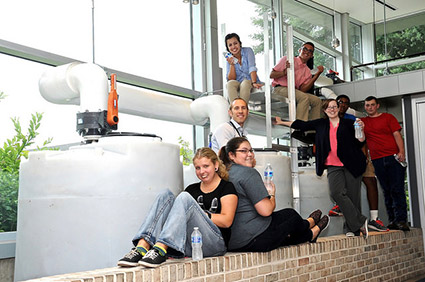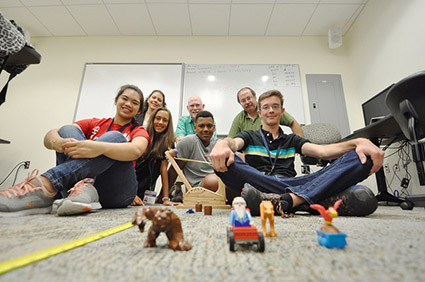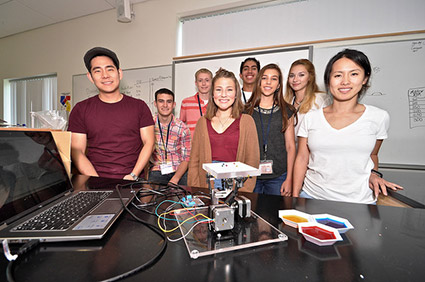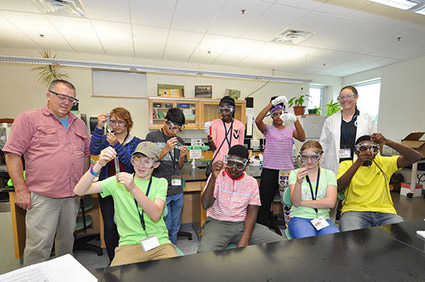- Home >
- Past Institutes >
- Home >
- 2017 Student and Teacher Projects
Students and teachers in the 2017 Joint Science and Technology Institute took part in research projects in a variety of scientific disciplines.
High School Student Projects
Fused Deposition Modeling Based 3D Printing
Fused deposition modeling is used for 3D prototyping in additive manufacturing. Students will each build a 3D printer, learning the corresponding electronics and construction. Student will trouble shoot the assembly and calibrate all components. Students will learn a CAD program to engineer and 3D print their own designs.
Environmental Water Quality

The Chesapeake Bay watershed includes the states of Pennsylvania, Maryland, Delaware and Virginia as well as the District of Columbia. Runoff from land, storm water, and wastewater treatment plants contribute to the water in the stream and rivers which flow into the bay impacting the ecosystems found there. Too much of any pollutants from the various water sources can have a negative effect on the bay, causing the depletion of necessary oxygen and the death of the fish and the overall life in the bay. Students will collect water samples from several locations in the Chesapeake Watershed and analyze them for nitrate, ammonia, phosphate, and bacteria. Based on the measurements, students will be able to piece together how human and natural activity can impact the Bay's ecosystem.
Rapid Prototyping & Military Packaging
Students will design, build and test unique items and their packaging against the rugged military environment. Working with engineers and specialists from Advance Design & Manufacturing, the students will use SolidWorks, 3D printing, and other rapid prototyping technologies to analyze, model and build Widgets. Students will select from military specification packaging materials to protect their Widgets, and test both prototypes and packaging against the extreme conditions encountered by military material.
Mathematics and Modeling Mania

Students will be introduced to the statistics and math modeling used by Operations Research (OR) analysts for a variety of tasks. Starting with the basics of probability, statistics and the modeling of a physical system, we will then move into some hands-on experiments with statapults (catapult). This provides a physical setting for students to apply statistics and design of experiments--important components in generating and analyzing data for model development. Student will conduct toxicology modeling, and a simplified model for disease propagation as a simulation to demonstrate how various pathogen parameters and countermeasures impact the worldwide spread of a contagion. Students will be given a primer on how several real-world diseases behave then given the option to enhance their pathogen of choice to more fully infect the world in the simulation. The second phase of this project will introduce the math and science behind coordinate systems, navigation (including GPS), meteorology, and simplified atmospheric transport and dispersion of pollutants/hazards. We will then use the Hazard Prediction and Assessment Capability (HPAC) simulation from the Defense Threat Reduction Agency (DTRA) to examine what might happen from various kinds of chemical, biological, radiological, and nuclear (CBRN) releases at locations near and dear to the students. Rounding out their experience will be some introductions to various methods for individual protection from CBRN hazards, computing hardware, and binary math.
Robotics
The field of robotics is growing by leaps and bounds: from movie props to performing delicate surgeries. As an introduction to robotics, students will explore the gambit of emerging trends and future applications in the industry including traditional uses like welding and high speed sortation through to drones and humanoids. Students will then get hands-on by designing, building, and programming robots to score points in a competition. The basic engineering principles from mechanical design and assembly to algorithms and coding will also be introduced.
Raspberry Pi
Raspberry Pi is a small, inexpensive, and low-power Linux computer. It is a very flexible machine and is an inexpensive way to access a relatively large amount of computer power. Students will build a Raspberry Pi computer, learn to program, and interact with electronics they design. Students will be able to connect a wide range of sensors, motors, and USB devices to create unique devices that respond to and control the physical world using the Raspberry Pi.
Motorized Droplet Actuation System (Exploring Engineering through Hopping the Droplets)

Motorized droplet actuation system is used to manipulate the droplets on a superhydrophobic surface (created on plastic sheets) by gravitational forces and mechanical agitation. The superhydrophobic plastic sheets are further printed with unique symbols using a hydrophilic ink. A microcontroller controls the direction and timing of two stepper motors which, in turn, provide mechanical agitation for droplet transport. Droplets remain confined to the hydrophilic symbols, and are able to ‘hop’ to neighboring symbols by gravity when the surface is agitated and tilted to a certain degree. Using this basic principle, the following droplet operations can be performed: transport of single and multiple droplets, transport of larger-volume droplets, merging and mixing of multiple droplets, dispensing of fixed-volume droplets from a large droplet or liquid reservoir, and one-directional movement of droplets. 1. The system comprises three structural components: base, column, and stage with plastic sheet. The base is physically screwed to the column. A universal joint connects the column to the stage. A microcontroller interfaces with two stepper motors (attached with individual timing belts) and controls the mechanical tilting of the stage. The plastic sheet is taped on the top of the stage. 2. A plastic sheet is spray-coated with a superhydrophobic chemical and printed with hydrophilic symbols using an inkjet printer 3. A graphical user interface (GUI) software is developed in Matlab to remotely access and control the mechanical movement of the droplet actuation system.
Cybersecurity & Digital Forensics
The demand for cybersecurity and digital forensics professionals has exploded in the digital age. We will work on learning the basics of cybersecurity and digital forensics. Students will explore different topics that will help them understand data security and recovery. Students will participate in hands-on, real world case studies that include cracking a website's password and hiding secret messages in the footprint of digital images. Students will also get a basic grasp of computer programming concepts. This project will be concluded by competing in a two day cyber games competition that will allow students to apply the skills gained through the institute.
3D Printing
The JSTI project will have two main objectives. 1. Students will partner with Army Research Laboratory (ARL) staff to build a 3D printer from a kit, and calibrate the printer for optimal fabrication, and 2. use this printer and a variety of other 3D printers to fabricate functional devices. An example of a functional device is a living hinge, which is a flexible area of a larger rigid component that is made of the same material. Living hinges can be fabricated by thinning of a section in some cases, but with the capabilities of 3D printing, this can be accomplished by "creative geometry." Other functional devices may be investigated.
Middle School Student Projects
The Technology and Engineering of Drones and Pinewood Derby Cars
Students will research the evolution of drones, challenges in production, aerodynamic considerations, and safety. Additional focus will be on past, current, and future uses. Students will be ask to come up with a specific application that interests them (perhaps specific to their hometown) and report on how it could be implemented. Students will also have the opportunity to pilot their own drones. Additional activities will include the aerodynamic properties of different pinewood derby cars and a competition. A field trip will include a visit the campus of the University of Maryland - College Park.
Forensic Chemistry

A large portion of forensic chemistry is trying to figure out what an unknown substance is. This process is known as qualitative analysis. Spectral analysis furnishes the best general system for detection of substance. However, the necessary instruments for applying the principles of spectral analysis throughout the complete useful portion of the spectrum are quite expensive and frequently complicated. In this course, we will limit the application of spectral analysis to the visible portion of the spectrum. Using known properties of solubility, students will analyze unknowns and determine the presence or absence of particular ions. Students will learn to use an array of laboratory equipment, techniques, and observation skills.
3D Printing
3D printing is an additive manufacturing process whereby objects are built up from plastic filament, liquid resin, layers of powder, or even bio-compatible and edible materials. Desktop 3D printing is today’s printing press, putting rapid prototyping, customizable products, and individualized medical appliances in reach of the general public. Literacy in basic 3D modeling and manufacturing is an essential skill for future STEM success in this country. In this course students will learn how to be “makers” by using various types of 3D modeling software, printing actual physical objects that they have designed and modeled themselves, and participating in educational outreach in the university and the community.
Teacher Projects
Mining the Aerobiome for Novel Antimicrobial Compounds
The need for new antibiotic classes and drug scaffolds is critical as resistance to available antibiotics continues to rise, and few, if any, new antibiotic classes have been introduced within the last 10 years. Approximately two-thirds of all known antibiotics are produced by actinomycetes, making these organisms an important player in the fight against emerging multidrug-resistant pathogens. The extreme environmental conditions of the lower atmosphere provide an easily-accessible reservoir of these novel bacteria as the relatively inhospitable conditions of this environment enrich for rare actinomycetes over the more abundant, but less tolerant, microbes found in the soil. This project is directed at the development of an antimicrobial discovery pipeline that queries bacteria found in atmospheric aerosols for novel antibiotic biosynthesis pathways with the potential to produce new drug moieties and scaffolds. Compounds discovered as a result of this effort will be correlated with a geographical location, altitude and underlying terrestrial biome, and be used to enrich the repertoire of potential new antibiotic scaffolds while delivering concrete new understanding of the nature and composition of the aerobiome.
Solar Degradation of Organisms (Influence of Irradiation at Multiple Wavelengths)
A critical component to understanding the fate of biological warfare agents is the degradation of these compounds by UV light. Due to the influence of ozone in the atmosphere, much of the energetic wavelengths of UV light are filtered out, leaving the UV-B and UV-A bands. While the UV-B band possesses germicidal properties by damaging the DNA within organisms, longer wavelengths in the UV-A and visible wavelengths are thought to aid DNA repair mechanisms. To truly understand the degradation of organisms under solar irradiation, measurements should be performed that capture the interplay of damage and repair mechanisms. For the JSTI Summer Program, the teacher will work with measurements of the degradation of simulants, Biosafety level 1 organisms (organisms not known to cause pathogenesis in humans, egg whites also fall into this category) under exposure to simulated solar light. Light is generated from a solar simulator that consists of a high power Xenon lamp that is filtered to mimic the wavelengths of sunlight that reach the earth's surface. These results will be compared to measurements performed with individual UV wavelengths to assess the effect of DNA repair mechanisms aided by longer wavelength light. It is expected the teacher will gain experience in 1) environmental chemistry, 2) some basic aerosol science, and 3) microbiology.
In Vitro Blood-Brain and Intestinal Barrier Models for Prediction of Permeability Characteristics in the Drug Discovery Pipeline
Within the USAMRICD ADMET (Absorption, Distribution, Metabolism, Excretion, and Toxicology) Center of Excellence, we use in vitro assays to predict if a new chemical compound has properties that would allow us to develop the compound as a drug/therapeutic. This laboratory is responsible for running assays to predict if the compound can be absorbed through the intestinal tract for drugs taken orally and if the compound can pass through the blood-brain barrier to reach the brain to treat neurological conditions. In this project, Madin Darby Canine Kidney (MDCK) cells and MDCK cells transfected with the human Multi-Drug Resistance Gene 1 (MDR1) will be grown and used for predicting intestinal and blood-brain barrier permeability constants, respectively. The theory and science behind the assay will be conveyed. This will be the main focus of the project. The second focus of my laboratory is to investigate how gene expression changes in response to chemical exposures. The theory and practice of microarray technology to detect gene expression changes and the techniques to isolate RNA from tissue sources will also be discussed.
3D Printing
The teacher will partner with Army Research Laboratory (ARL) staff to build a 3D printer from a kit, and calibrate the printer for optimal fabrication. This will provide the teacher with experience necessary to develop an inexpensive 3D printing program in their classroom. Additionally, the teacher will use this printer and a variety of other 3D printers to fabricate functional devices. The design process will involve geometry, algebra, and engineering. This provides a project-based platform for projects which can be aligned with local and state standards.
Military Packaging
The teacher will design, build and test unique items and their packaging against the rugged military environment. Working with engineers and specialists from Advance Design & Manufacturing, the teacher will use SolidWorks, 3D printing, and other rapid prototyping technologies to analyze, model and build Widgets. The teacher will select from military specification packaging materials to protect the Widgets, and test both prototypes and packaging against the extreme conditions encountered by military material. This project will provide the teacher with an interdisciplinary approach to mathematics, engineering, and material sciences.
Acetylcholinesterase Reactivation
The teacher will assist in two laboratories. 1. In the acetylcholinesterase reactivation laboratory, the teacher will learn to use a robot to perform a reactivation assay. With the assay data, the teacher will utilize Excel workbooks developed for the analysis, (they will dig beneath the surface and learn about the underlying Visual Basic for Applications code) 2. In the molecular modelling lab, the teacher will help prepare molecular models of small molecules for docking into proteins. There are several programs that the teacher will learn and utilize to do this.
Fused Deposition Modeling Based 3D Printing
Fused deposition modeling is used for 3D prototyping in additive manufacturing. Teachers will each build a 3D printer, learning the corresponding electronics and construction. Teachers will trouble shoot the assembly and calibrate all components. Teachers will work with CAD program to engineer and 3D print their own designs. As a foundation for new careers in additive manufacturing, teachers will be able to demonstrate the multiple uses and career paths for FDM-based 3D printing. The engineering challenge and technical components of building and calibration provide real-life examples of mathematics and engineering career opportunities.
Development of a Real-Time Point- of-Care In Vitro Diagnostic Device
The teacher will assist in the development of a real-time point-of-care in-vitro diagnostic device that could be used to measure and monitor therapeutic levels of a protein-based drug that destroys nerve agent in blood circulation. The teacher will not directly handle nerve agent during the project. The teacher will handle small volumes of protein samples and use screen-printed-electrodes to qualify and quantify enzyme kinetics of the drug via electrochemistry. Data analysis will include fitting observed data via linear regression to determine enzyme activity.
